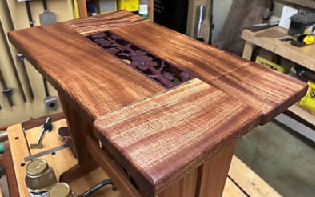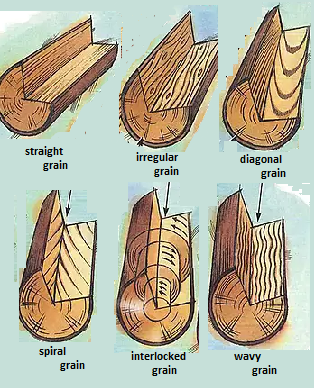Essays Contents
Wood
December 1, 2023

Watch this side table being crafted.
Make Woodwork Sexy Again! Side Table Build
The Samurai Carpenter YT channel
This "side table" is made from Sapele.
I was not familiar with this kind of wood before now...
and so... I read up on it... and...
I learned about all the wonders... in the skill of carpentry.
It's... ART...!!! Skilled carpenters are... masters.

About the wood... Sapele
from: The Wood Database
Color/Appearance:
Its heartwood is a golden to dark reddish brown.
Color tends to darken with age.
Besides the common ribbon pattern
seen on quartersawn boards,
sapele is also known for a wide variety
of other figured grain patterns, such as:
pommele, quilted, mottled, wavy,
beeswing, and fiddleback.

Warning: This is a rabbit hole.
You may choose to follow the trail of each of these wood patterns
and learn the details of wood grains... and all the beauty of them...
or put it aside for chasing after... later.
There's more to know about Sapele...!!
continuing

Sapele has a distinct, cedar-like scent while being worked.
Sapele can be troublesome to work in some machining operations,
(i.e., planing, routing, etc.), resulting in tearout due to
its interlocked grain.
It will also react when put into direct contact with iron,
becoming discolored and stained.
Sapele has a slight blunting effect on cutters,
but it turns, glues, and finishes well.
Most mahogany-like woods are scentless and
can be separated from sapele on the basis of odor.
However, bosse (Leplaea cedrata) is a
closely related African hardwood
that can have similar appearance and scent.
Separation can be difficult, but bosse generally is lighter in color,
and has more extensive and consistent parenchyma bands --
with the bands in sapele being more sporadic.


Understanding Wood Grain
from: Wood Magazine
A craftsman selects a certain type of wood for a project
because of a number of reasons. Grain is one.
Yet that word has many meanings.
1. Straight grain means that the fibers in a board
run roughly parallel with the vertical axis
of the log from which it was sawn.
2. In boards with irregular grain, the wood fibers
run at varying and irregular directions from
the vertical axis of the log, such as around knots.
3. Diagonal grain results when an otherwise
straight-grained log isn't sawn along its vertical axis.
4. A tree that somehow grew twisted produces a log and subsequent
boards with spiral grain, where the fibers follow a spiral
course with either a left-or-right-hand twist.
5. Interlocked grain comes from trees whose fibers
in each growth layer tended to align in opposite directions.
6. When the direction of the wood fibers constantly changes,
the board has wavy grain.

Sapele from:
Woodworking Network

Author of this article:
Sapele (pronounced sa-pee’-lee) is in the African mahogany family.
Indeed, sapele (Entandrophragma cylindricum) has the appearance of
African mahogany; that is, sapele is dark reddish brown with a ribbon pattern.
It is actually heavier, stronger and harder than African mahogany.
Its excellent working properties and wonderful appearance result in a moderate
to high price in the lumber market. This wood is also available as veneer.
The tree grows in the tropical rain forests of Africa, ranging from the Ivory Coast to Cameroon and eastward through Zaire to Uganda. On the edge of its range, it has been harvested heavily and may be nearing extinction; however, in most of its range it is more plentiful and can be grown in plantations, assuring good supplies into the future with good forestry practices.
The tree in the natural forest will reach a height ranging from 100 to 150 feet, with some trees reaching 200 feet in height. Tree diameters can reach 6 feet, although 4 to 5 feet are more common. The merchantable stem is typically straight, free of branches and over 100 feet long. As might be imagined, this large tree produces tremendous volumes of clear lumber and veneer.
As the tree is growing, the vertical cells do not align vertically in the tree, but are aligned at a small angle. In other words, the grain spirals up the tree, similar to the stripes of a candy-cane. The direction of rotation also reverses from year to year. This phenomena is called, when the wood is sawn into lumber,
interlocked grain. When quartersawn or riftsawn, this interlocked grain creates a wonderful (and desirable) ribbon pattern on the face of the lumber.
As with many imported species, this wood is subject to attack by powderpost beetles which are common in tropical regions. They can be eliminated by fumigation when shipping or kiln drying above 133 degrees F. Once treated, the “sterilized” wood must be kept away from unsterilized, infected wood.
Density
Sapele is similar in density to red oak, but heavier than mahogany. Kiln-dried wood has a density of 36 pounds per cubic foot. Lumber planed to ¾ inch thickness 7 percent MC will weigh about 2-1/4 pounds per board foot.
Drying and Stability
Sapele may be dried at the sawmill, but it is not uncommon to bring the wet wood to the U.S. for drying. It dries rapidly, but the interlocked grain results in a strong tendency to warp. This warp is best controlled by excellent stacking and low initial temperatures. Kiln schedules are similar to red oak.
Overall shrinkage in drying (about 5-1/2 percent in width of flatsawn lumber and 3-1/2 percent for quartersawn) is not excessive.
This wood moves somewhat in service when the humidity changes. Quartersawn lumber that shows the ribbon stripe will actually be fairly stable in width, requiring a 6 percent MC change to produce a 1 percent size change. Flatsawn lumber will move 1 percent with a 4 percent MC change.
Gluing and Machining
Gluing is moderately easy, but with the high density of the wood surfaces should be flat and freshly prepared. There are no resins to deal with.
The interlocked grain means that on quartersawn and rift surfaces, the tool is always cutting some of the fibers “against the grain.” Tear-out (torn grain, chip-out) is therefore likely, especially for low MCs and slender knives. The hook angle should be small so that the knife acts more like a plow than like a splitting chisel.
Strength
Sapele is a little stronger than red oak. The bending strength (MOR) is 15,300 psi, the elasticity (MOE) is 1.82 million psi, and the hardness is 1510 pounds.
Screw and nail holding is very high; predrilling of screw and nail holes near the ends of the pieces is be suggested to avoid splitting.
Color and Grain
Sapele is almost always 100 percent heartwood. The heartwood is dark reddish brown with a purplish cast. The grain texture rather fine, similar to mahogany. The interlocked grain on quartersawn surfaces produces the ribbon like pattern. There is a very slight aroma at times which smells a bit like cedar.
When sanded smooth, the wood has a slight luster. It may be necessary to use a sealer on the wood surfaces (or use multiple coats), as there can be variations in absorption of the finishes without a sealer.

Finding Joy in Simplicity

the mokuomo blog
Slow living: Treehouses
the mokuomo blog
The Meaning of Sapele Wood
from mokuomo blog
Since ancient times, sapele wood has already been very popular among Africans.
Apart from its spiritual metaphor, it is also because sapele wood has very strong
wind resistance ability. The wood is also solid, strong, durable, and very resistant
to termites. It is considered as one of the best materials for building wood
infrastructure. In addition to this, musical instruments made of sapele wood
are also of high quality and with very strong sound penetration, which are
widely favored in the music industry.
Meaning To Health
In Africa, sapele wood has a sacred symbol, symbolizing spiritual healing
and spiritual health, and is hailed as a type of sacred wood by the locals.
Then, sapele wood was spread to Europe, America and Asia.
Because of the influence of the traditional African culture, many people started
to believe that sapele wood can help us to stay calm and focused, and it is also
a panacea for mental and spiritual health. In view of this, people perceive sapele
wood as an excellent material for making meditation tools, which can
effectively help people to cleanse their mind.
Characteristics Of Sapele Wood
Sapele wood is mainly distributed in the tropical regions of Africa.
Sapele wood has a delicate wood texture and a very smooth surface
with impressive tropical aroma. It has a charming reddish-brown
nostalgic color. The pattern of sapele wood is interlaced and wavy.
Moreover, under sunlight, sapele wood will reveal a bright luster,
which highlights its fine and dense wood grain.
Sapele wood has so many impressive meanings and characteristics.
If you are interested, please feel free to check out our collection.
We are Mokuomo. Our vision is to craft, polish and strive to offer
the most natural and minimalist collection
for everyone to practice slow living.

Make Woodwork Sexy Again! Side Table Build
The Samurai Carpenter YT channel

About the wood... Sapele
from: The Wood Database
Color/Appearance:
Its heartwood is a golden to dark reddish brown.
Color tends to darken with age.
Besides the common ribbon pattern
seen on quartersawn boards,
sapele is also known for a wide variety
of other figured grain patterns, such as:
pommele, quilted, mottled, wavy,
beeswing, and fiddleback.


Sapele has a distinct, cedar-like scent while being worked.
Sapele can be troublesome to work in some machining operations,
(i.e., planing, routing, etc.), resulting in tearout due to
its interlocked grain.
It will also react when put into direct contact with iron,
becoming discolored and stained.
Sapele has a slight blunting effect on cutters,
but it turns, glues, and finishes well.
Most mahogany-like woods are scentless and
can be separated from sapele on the basis of odor.
However, bosse (Leplaea cedrata) is a closely related African hardwood
that can have similar appearance and scent.
Separation can be difficult, but bosse generally is lighter in color,
and has more extensive and consistent parenchyma bands --
with the bands in sapele being more sporadic.


Understanding Wood Grain
from: Wood Magazine
A craftsman selects a certain type of wood for a project
because of a number of reasons. Grain is one.
Yet that word has many meanings.
1. Straight grain means that the fibers in a board
run roughly parallel with the vertical axis
of the log from which it was sawn.
2. In boards with irregular grain, the wood fibers
run at varying and irregular directions from
the vertical axis of the log, such as around knots.
3. Diagonal grain results when an otherwise
straight-grained log isn't sawn along its vertical axis.
4. A tree that somehow grew twisted produces a log and subsequent
boards with spiral grain, where the fibers follow a spiral
course with either a left-or-right-hand twist.
5. Interlocked grain comes from trees whose fibers
in each growth layer tended to align in opposite directions.
6. When the direction of the wood fibers constantly changes,
the board has wavy grain.

Sapele from:
Woodworking Network

Author of this article:
Sapele (pronounced sa-pee’-lee) is in the African mahogany family.
Indeed, sapele (Entandrophragma cylindricum) has the appearance of
African mahogany; that is, sapele is dark reddish brown with a ribbon pattern.
It is actually heavier, stronger and harder than African mahogany.
Its excellent working properties and wonderful appearance result in a moderate
to high price in the lumber market. This wood is also available as veneer.
The tree grows in the tropical rain forests of Africa, ranging from the Ivory Coast to Cameroon and eastward through Zaire to Uganda. On the edge of its range, it has been harvested heavily and may be nearing extinction; however, in most of its range it is more plentiful and can be grown in plantations, assuring good supplies into the future with good forestry practices.
The tree in the natural forest will reach a height ranging from 100 to 150 feet, with some trees reaching 200 feet in height. Tree diameters can reach 6 feet, although 4 to 5 feet are more common. The merchantable stem is typically straight, free of branches and over 100 feet long. As might be imagined, this large tree produces tremendous volumes of clear lumber and veneer.
As the tree is growing, the vertical cells do not align vertically in the tree, but are aligned at a small angle. In other words, the grain spirals up the tree, similar to the stripes of a candy-cane. The direction of rotation also reverses from year to year. This phenomena is called, when the wood is sawn into lumber, interlocked grain. When quartersawn or riftsawn, this interlocked grain creates a wonderful (and desirable) ribbon pattern on the face of the lumber.
As with many imported species, this wood is subject to attack by powderpost beetles which are common in tropical regions. They can be eliminated by fumigation when shipping or kiln drying above 133 degrees F. Once treated, the “sterilized” wood must be kept away from unsterilized, infected wood.
Density
Sapele is similar in density to red oak, but heavier than mahogany. Kiln-dried wood has a density of 36 pounds per cubic foot. Lumber planed to ¾ inch thickness 7 percent MC will weigh about 2-1/4 pounds per board foot.
Drying and Stability
Sapele may be dried at the sawmill, but it is not uncommon to bring the wet wood to the U.S. for drying. It dries rapidly, but the interlocked grain results in a strong tendency to warp. This warp is best controlled by excellent stacking and low initial temperatures. Kiln schedules are similar to red oak.
Overall shrinkage in drying (about 5-1/2 percent in width of flatsawn lumber and 3-1/2 percent for quartersawn) is not excessive.
This wood moves somewhat in service when the humidity changes. Quartersawn lumber that shows the ribbon stripe will actually be fairly stable in width, requiring a 6 percent MC change to produce a 1 percent size change. Flatsawn lumber will move 1 percent with a 4 percent MC change.
Gluing and Machining
Gluing is moderately easy, but with the high density of the wood surfaces should be flat and freshly prepared. There are no resins to deal with.
The interlocked grain means that on quartersawn and rift surfaces, the tool is always cutting some of the fibers “against the grain.” Tear-out (torn grain, chip-out) is therefore likely, especially for low MCs and slender knives. The hook angle should be small so that the knife acts more like a plow than like a splitting chisel.
Strength
Sapele is a little stronger than red oak. The bending strength (MOR) is 15,300 psi, the elasticity (MOE) is 1.82 million psi, and the hardness is 1510 pounds.
Screw and nail holding is very high; predrilling of screw and nail holes near the ends of the pieces is be suggested to avoid splitting.
Color and Grain
Sapele is almost always 100 percent heartwood. The heartwood is dark reddish brown with a purplish cast. The grain texture rather fine, similar to mahogany. The interlocked grain on quartersawn surfaces produces the ribbon like pattern. There is a very slight aroma at times which smells a bit like cedar.
When sanded smooth, the wood has a slight luster. It may be necessary to use a sealer on the wood surfaces (or use multiple coats), as there can be variations in absorption of the finishes without a sealer.

Finding Joy in Simplicity

the mokuomo blog
Slow living: Treehouses
the mokuomo blog
The Meaning of Sapele Wood
from mokuomo blog
Since ancient times, sapele wood has already been very popular among Africans.
Apart from its spiritual metaphor, it is also because sapele wood has very strong
wind resistance ability. The wood is also solid, strong, durable, and very resistant
to termites. It is considered as one of the best materials for building wood
infrastructure. In addition to this, musical instruments made of sapele wood
are also of high quality and with very strong sound penetration, which are
widely favored in the music industry.
Meaning To Health
In Africa, sapele wood has a sacred symbol, symbolizing spiritual healing
and spiritual health, and is hailed as a type of sacred wood by the locals.
Then, sapele wood was spread to Europe, America and Asia.
Because of the influence of the traditional African culture, many people started
to believe that sapele wood can help us to stay calm and focused, and it is also
a panacea for mental and spiritual health. In view of this, people perceive sapele
wood as an excellent material for making meditation tools, which can
effectively help people to cleanse their mind.
Characteristics Of Sapele Wood
Sapele wood is mainly distributed in the tropical regions of Africa.
Sapele wood has a delicate wood texture and a very smooth surface
with impressive tropical aroma. It has a charming reddish-brown
nostalgic color. The pattern of sapele wood is interlaced and wavy.
Moreover, under sunlight, sapele wood will reveal a bright luster,
which highlights its fine and dense wood grain.
Sapele wood has so many impressive meanings and characteristics.
If you are interested, please feel free to check out our collection.
We are Mokuomo. Our vision is to craft, polish and strive to offer
the most natural and minimalist collection
for everyone to practice slow living.

